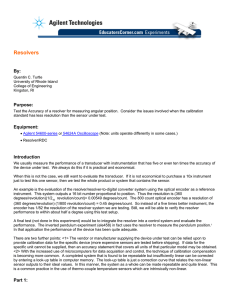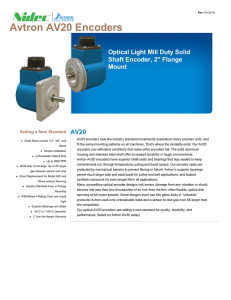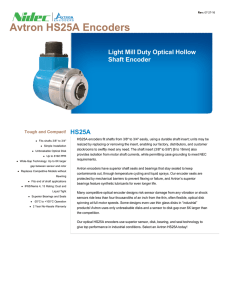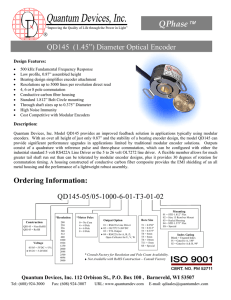TECHNICAL NOTE Encoder vs. Resolver-Based Servo
advertisement
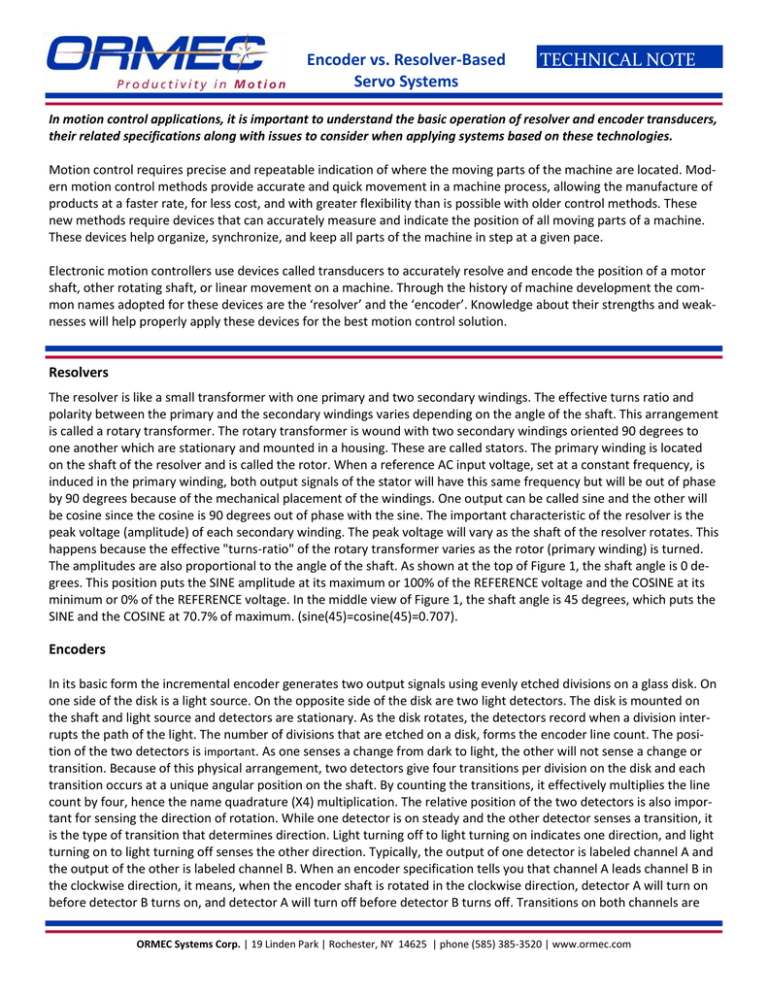
Encoder vs. Resolver-Based Servo Systems TECHNICAL NOTE In motion control applications, it is important to understand the basic operation of resolver and encoder transducers, their related specifications along with issues to consider when applying systems based on these technologies. Motion control requires precise and repeatable indication of where the moving parts of the machine are located. Modern motion control methods provide accurate and quick movement in a machine process, allowing the manufacture of products at a faster rate, for less cost, and with greater flexibility than is possible with older control methods. These new methods require devices that can accurately measure and indicate the position of all moving parts of a machine. These devices help organize, synchronize, and keep all parts of the machine in step at a given pace. Electronic motion controllers use devices called transducers to accurately resolve and encode the position of a motor shaft, other rotating shaft, or linear movement on a machine. Through the history of machine development the common names adopted for these devices are the ‘resolver’ and the ‘encoder’. Knowledge about their strengths and weaknesses will help properly apply these devices for the best motion control solution. Resolvers The resolver is like a small transformer with one primary and two secondary windings. The effective turns ratio and polarity between the primary and the secondary windings varies depending on the angle of the shaft. This arrangement is called a rotary transformer. The rotary transformer is wound with two secondary windings oriented 90 degrees to one another which are stationary and mounted in a housing. These are called stators. The primary winding is located on the shaft of the resolver and is called the rotor. When a reference AC input voltage, set at a constant frequency, is induced in the primary winding, both output signals of the stator will have this same frequency but will be out of phase by 90 degrees because of the mechanical placement of the windings. One output can be called sine and the other will be cosine since the cosine is 90 degrees out of phase with the sine. The important characteristic of the resolver is the peak voltage (amplitude) of each secondary winding. The peak voltage will vary as the shaft of the resolver rotates. This happens because the effective "turns-ratio" of the rotary transformer varies as the rotor (primary winding) is turned. The amplitudes are also proportional to the angle of the shaft. As shown at the top of Figure 1, the shaft angle is 0 degrees. This position puts the SINE amplitude at its maximum or 100% of the REFERENCE voltage and the COSINE at its minimum or 0% of the REFERENCE voltage. In the middle view of Figure 1, the shaft angle is 45 degrees, which puts the SINE and the COSINE at 70.7% of maximum. (sine(45)=cosine(45)=0.707). Encoders In its basic form the incremental encoder generates two output signals using evenly etched divisions on a glass disk. On one side of the disk is a light source. On the opposite side of the disk are two light detectors. The disk is mounted on the shaft and light source and detectors are stationary. As the disk rotates, the detectors record when a division interrupts the path of the light. The number of divisions that are etched on a disk, forms the encoder line count. The position of the two detectors is important. As one senses a change from dark to light, the other will not sense a change or transition. Because of this physical arrangement, two detectors give four transitions per division on the disk and each transition occurs at a unique angular position on the shaft. By counting the transitions, it effectively multiplies the line count by four, hence the name quadrature (X4) multiplication. The relative position of the two detectors is also important for sensing the direction of rotation. While one detector is on steady and the other detector senses a transition, it is the type of transition that determines direction. Light turning off to light turning on indicates one direction, and light turning on to light turning off senses the other direction. Typically, the output of one detector is labeled channel A and the output of the other is labeled channel B. When an encoder specification tells you that channel A leads channel B in the clockwise direction, it means, when the encoder shaft is rotated in the clockwise direction, detector A will turn on before detector B turns on, and detector A will turn off before detector B turns off. Transitions on both channels are ORMEC Systems Corp. | 19 Linden Park | Rochester, NY 14625 | phone (585) 385-3520 | www.ormec.com transmitted back to the quadrature interface and counted with a digital counter circuit. The Z channel which detects the once per revolution index mark is included as a reference point if required Regarding Absolute Position A fundamental difference between resolvers and incremental encoders is that resolvers determine absolute shaft position directly. With encoders, only incremental shaft movement is tracked directly, and absolute shaft position is determined by a third photo sensor which reads a “zero reference track” sensing a unique position once per revolution of the device. The result of this is that when power is first applied, an incremental encoder based system does not know absolute shaft position until the encoder is moved far enough to pass the first zero reference position. This poses a problem for brushless servo designers, since the servodrive must know absolute shaft position in order to commutate the servomotor allowing it to generate torque and move. This problem is commonly overcome by adding additional encoder tracks which provide absolute shaft position information for the servodrive. Independent of whether an encoder or a resolver is used for determining motor position, it has become a de-facto standard for brushless servodrives to provide position information for the user in the form of three signals which correspond to encoder quadrature and a once-per revolution reference. Regarding Resolution: Resolution in the encoder is based on evenly spaced divisions or line counts on a glass or metal disk. Using integrated semiconductor techniques for etching the glass disk and aligning the detectors one can produce line counts of over 10,000 with exceptional precision. On the other hand, resolution of a resolver system is solely based on the techniques of the analog-to-digital conversion method used by the resolver-to-digital converter electronics. The angle of the shaft within the 90 degree quadrant has to be resolved into a digital format. The popular conversion method is a 'tracking' process. First the two resolver signals (sine and cosine) are combined to reconstruct the reference signal. Then a digital counter holding a value representing the shaft angle, is modulated with the original reference signal. The modulated signal is subtracted from the reconstructed signal forming a difference signal. The difference signal becomes the 'error' value that is constantly forced to a zero amount by either incrementing or decrementing the digital counter in an effort to keep the value in the counter equal the angle of the resolver shaft. This continuous tracking process allows the system to obtain the angle at anytime. Therefore, the amount of usable resolution depends on how precise the circuits, of the resolver-to-digital converter that combine the signals to produce the angle, are designed and manufactured. The resolver-to-digital conversion system, like the encoder system, will limit the rotational speed of the resolver shaft. The ‘tracking rate’ is finite. Generally, like encoders, the greater a resolver's resolution is, the lower the tracking rate will be. But unlike encoders, the resolver's method of tracking has an inherent time lag of up to 15 milliseconds when it encounters velocity changes during hard accelerations. Performance is affected in applications such feed-and-cut when cut rates reach 1000 per minute. The cycle time at this rate is 60 milliseconds and if the feed time is half of the cycle, the resolver's lag can be 50% of the move time. Clearly this is not an application for a resolver-based system. Hard accelerations will not affect the encoder's ability to give the true position of the shaft, as long as its tracking rate is not exceeded. Regarding Accuracy: What is accuracy? It is a combination of component errors and uncertainty. Uncertainty defines how far the actual position could be from the ideal point. Uncertainty is a function of resolution. Resolution defines the number of ideal points a parameter can have. The space between the points is the uncertainty. In other words, when a system is presented with a value of the current point, it does not know how close it is to the points on either side of it. For an example; take one revolution of a shaft and divide it into 4096 parts. Since there are 60 minutes in one degree and 360 degrees in one revolution, there are 21,600 minutes (60 x 360) in a shaft revolution. Each division is spaced by 5.273 minutes (21,600/4096). If the device were perfect, the error would be +/- 0.00 but the accuracy would be +/- 5.273 minutes. Even though the system is presented with the ideal value, it could physically move from that point by 5.273 arcminutes before it would get an indication that it is on the next ideal point. Component error defines how close the value of a parameter is to the ideal point that the parameter represents. Errors in a device are determined by the qualORMEC Systems Corp. | 19 Linden Park | Rochester, NY 14625 | phone (585) 385-3520 | www.ormec.com ity of construction and the ability to be stable over temperature ranges and vibration levels. Now, let's compare encoder and resolver error. In a resolver system, each component contributes to the error from the resolver shaft back to the conversion process. These components include construction consistencies in the windings, signal scaling by the converter, signal mixing technology, reference phasing, and tracking methods. Typically signal, phasing, and tracking errors are lumped into the converter specification, and then the resolver's error is added for the total error. Typical error, without including uncertainty, for a general resolver system is 14 arc-minutes. Resolver error will exhibit characteristics that change the actual error at its resolution points depending on the temperature. This affects the resolver's ability to repeatedly be at the same position for the same point over the resolver's temperature range. Resolver error is also cyclic, meaning it will vary by the full range (+14 to -14 arc-min for this example) for one complete revolution of the shaft. The cyclic error will not accumulate as the shaft turns, but it may affect a control system's ability to produce torque and speed control with necessary quality for some applications. Error in a encoder accounts for how well the divisions on the disk are etched along with the placement of the light detectors. Today's photographic and semiconductor techniques, in a cost effective manner, can produce disks and detectors with errors of approximately 0.5 arc-minutes. The affect due to uncertainty and error on accuracy, can now be determined. For the resolver in this example, accuracy would be 14 arc-minutes + 5.273 arc-minutes for a total for 19.273. For the encoder with the same resolution, it would be 0.5 arc-minutes + 5.273 arc-minutes for a total of 5.773 . When we increase the resolution, which lowers the uncertainty, its affect on accuracy is better for the encoder than for the resolver. Typical accuracy for a 6000 line count (24000 counts) device is 1.40 arc minutes or 0.023 degrees. For a simple comparison, let's drive a 6 in. radius roll which has a 37.7 in. circumference and look at how accurately the surface of the roll can be positioned. Using a 4096 line count (16384 counts) resolver system with 15 arc-min accuracy is (15/21600) * 37.7 inches or 0.026 inches. Using the 6000 line count encoder system with 1.40 arc-min accuracy is (1.40/21600) * 37.7 inches or 0.0024 inches. Clearly, this example shows that encoders can be 10 times more accurate than resolvers with approximately the same line count. Electrical Interface Most controllers in today's market use the quadrature interface scheme. To accommodate these controllers, the resolver based drive will convert its digital format into signal transitions emulating channel A, B and Z of the encoder. Therefore the resolver based drive system, for all intents and purposes, will look as an encoder based drive system. Both transducer types use differential driver and receiver techniques in their electrical interface schemes. These differential techniques are designed to reject electrical noise induced into the cable. The shield wire will drain off the noise into the ground circuit before it can affect the transducer and produce additional error. Environmental Issues When comparing the specifications of either transducer type one finds that standard resolvers will survive in an extreme range of temperature, humidity environments, and will take higher shock levels. This difference is evident in the specification of a resolver based servomotor. The continuous duty zone is typically limited by the thermal environment of the motor's case. For a high TENV limit, internal motor case temperatures over 140 degrees C are normal. Clearly, this is an unqualified place for an encoder unless you lower the rated continuous duty zone enough to keep case temperatures below the safe operating specification of the encoder. In applications where environments are below freezing point of water such as frozen food processing and packaging, the resolver based system could be specified. Summary When the environment is hot, humid, oily, or dusty beyond normal industrial conditions the resolver-based system is the preferred choice. When precise positioning, smooth torque and stable velocity control are top priority for the application, the encoder-based system is the preferred choice. The choice is at best, application dependent, but other factors can play a role. All factors must be balanced for the right design fit. ORMEC Systems Corp. | 19 Linden Park | Rochester, NY 14625 | phone (585) 385-3520 | www.ormec.com For Further Reading: 1. ILC Data Device Corp., Synchro Conversion Handbook, Third Edition. 2. Dynamics Research Corp., Techniques for digitizing rotary and linear motion, Encoder Division, Fourth Printing. Specifications: Encoders vs. Resolvers Encoders Resolvers Standard resolution (counts per revolution) 32,640 16,384 Maxim Speed (counts per second) 2,448,000 500,000 Typical/Best Accuracy (arc-minutes) 1.5/1.0 15.0/7.0 Typical Tracking Response Time (milliseconds) <1 15 Tolerable Shock Level (G’s) 5 50 Operating Temperature Range (degree C) 0 to 100 -55 to 175 For more information Contact the motion control experts at ORMEC for further information. Please call us at (585) 385-3520 or email sales@ormec.com Visit our website at www.ormec.com ORMEC Systems Corp. | 19 Linden Park | Rochester, NY 14625 | phone (585) 385-3520 | www.ormec.com
